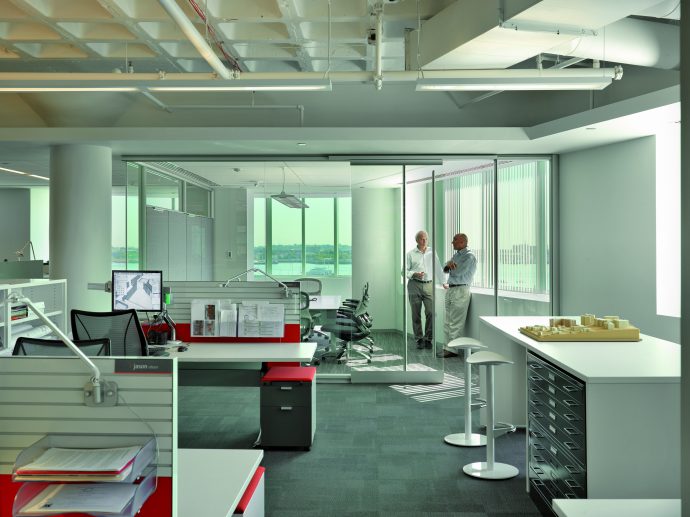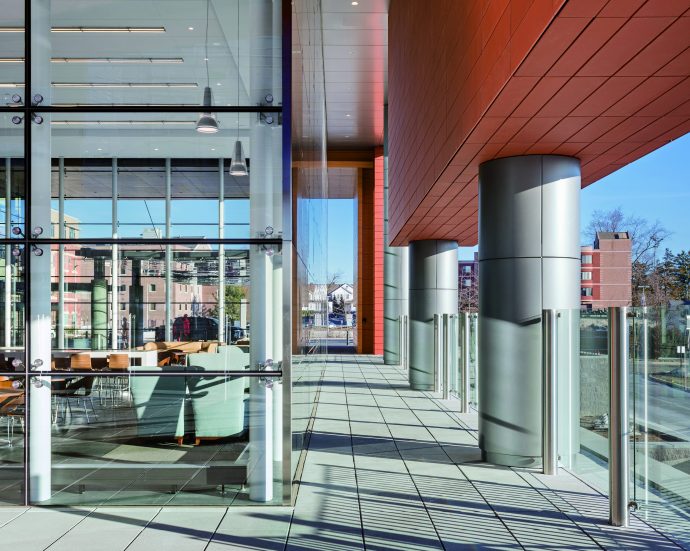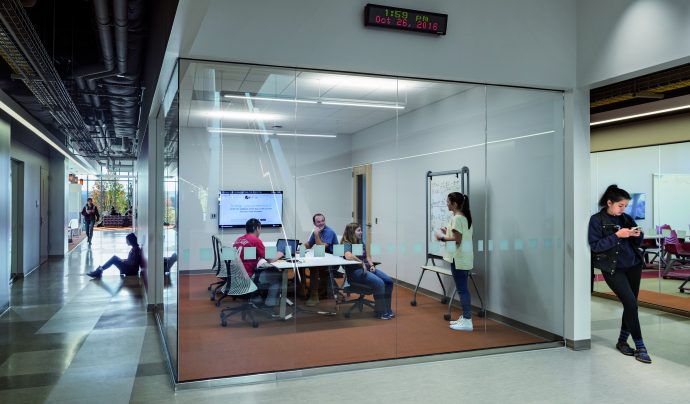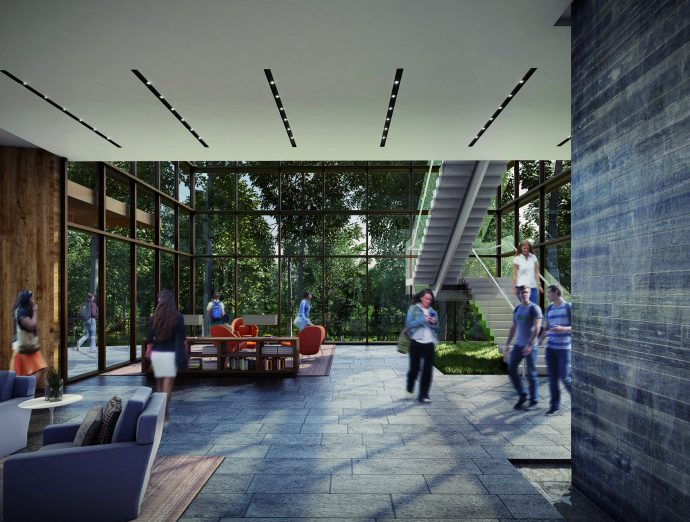Author and workplace design specialist, Leigh Stringer outlines important strategies that can be implemented to support emotional safety of not only abuse victims, but all employees as well.

After reading all of the stories in the news lately about sexual harassment, I am both horrified at the behavior of those accused, and at the same time relieved that this issue is getting some exposure. It is not acceptable and I can’t help but wonder how the design and construction industry can help deter bad behavior like this. Specifically, how can good design reduce the “opportunity” for bad behavior to occur in the first place, and also better support victims of sexual harassment or other forms of post-traumatic stress disorder (PTSD)? Good design can reduce traffic accidents, inspire us to pray, nudge us to eat less, encourage us to take more steps, and facilitate collaboration between colleagues. Why can’t we treat this issue like any other design problem?
When you think about it, emotional safety is more of an issue for workers today than physical safety. There are many physically unsafe jobs out there – firefighters, police, people in the military – but most of us are much more likely to encounter traumas of a different sort. To put things in perspective, the chances of being in an active shooter incident at work in the U.S. are over a million to one. By comparison, one in four women are impacted by sexual harassment at work. Actually, no one knows for sure because 75 percent of sexual assault victims never bother to report workplace sexual harassment out of fear of retaliation or not being believed. So, by putting some design focus on this issue, we could really make a difference.
What are important factors to consider when designing for emotional safety?
Laura Zam, a sexual healing coach and author of a forthcoming memoir about reclaiming power after sexual violation, has first-hand experience with victims of verbal abuse as well as sexual assault, most of whom experience this at work.
This kind of abuse can have a tremendous impact on work because the victim’s day can be consumed by strategies for getting away from a predator. This greatly affects productivity, because if someone is in a hyper-vigilant state, and it’s nearly impossible to concentrate, let alone be innovative or creative. In the aftermath of an altercation, the victim is also probably too upset to focus on work. – Laura Zam
Zam also suggests there is a case for giving victims a choice about where they work. “Getting away from an offending person might also affect when and where the victim works”, says Zam. She might be looking for ways to not be there at the same time, or ways to work in a location far away from a predator, even choosing to work from home or call in sick.”
Nancy Board, a workplace behavioral health and wellbeing expert with extensive experience working with victims of trauma, abuse, and harassment, has seen victims of sexual assault at work respond in a variety of ways.
Some women come straight back to work, pull themselves together and act as if nothing ever happened. They suffer in silence. For some women, it will manifest in taking more sick days, changing work roles, work assignments, or teams, moving to another business unit, or even resigning to find another employer. Some women will also display more signs of stress, such as anxiety, depression, and possibly weight fluctuations. They may even demonstrate more anger or aggressive behavior at work. Since there is still a fear of retaliation, blame, and shame, women tend to find withdraw and find ways to avoid their harasser or abuser. If they are lucky, they will seek out self-care practices such as counseling either through a private practitioner or thru the company EAP. – Nancy Board
When someone is sexually harassed at work, it impacts morale, job satisfaction, and turnover. The psychological impact can be devastating to the victim, but also impact their team and many others in the organization. It’s a big, big deal when it comes to employee wellbeing. But, you may be asking yourself, how can the physical environment at work possibly help with this issue?
Strategies that support emotional safety in workplace design
Those of us who design buildings think about physical safety all the time, for example, building security, how to egress out of a building in case of fire, or how to handle responding to an active shooter. Fortunately, for most of these physical safety concerns, there are best practices and building codes available to help minimize our physical injury or danger. There are, in fact building security consultants who think about this every day, and provide companies advice on how to keep buildings safe for occupants – and they make a lot of money I might add.
But when it comes to designing emotional safety into the built environment, there really are no formal guidelines. Most protocols around the prevention of sexual harassment are written for management or human resources audiences, and design guidelines for those with PTSD are often written for hospitals. But that doesn’t mean those of us who design and operate offices, schools, courthouses, and other workplaces should be let off the hook. There is a lot we can and should do to prevent the opportunity for bad behavior, and to foster a psychologically safe and healthy work environment.
Here are nine design strategies to get you thinking:
1) Provide open office space for employees (at least as an option)
A friend of mine who specializes in wellness recently told me a story about a new health and wellness center at his company. He explained that the wellness director had designed several different kinds of collaboration environments within the center, including private rooms, open areas, and cafe settings. My friend was confused at first as to why there needed to be so many different settings for meeting with employees, until he watched a woman come in one day looking to have a very personal conversation with one of the health counselors. The counselor directed her to a private office to talk, but she stopped him and suggested they sit in an open area because she felt uncomfortable being in an enclosed office alone with a man. She just didn’t feel safe in that environment.
Sometimes the most comfortable place in the room is a where others are in plain view. According to Nancy Board, “It’s important that women are not ‘trapped’ in corner areas or exposed to areas where they may be locked into a space/office.” This may be the best argument for open office space yet.

2) Allow employees to work how, where, and when they are most comfortable
Many companies are moving to flexible work environments and flexible work arrangements. There is a great deal of evidence that by increasing employee “control” regarding in how, when, or where work happens not only improves productivity, but also improves health (by reducing heart disease and other chronic issues). When employees have experienced trauma or are dealing with a predator at work, it becomes even more important to give them some autonomy.
In addition to providing a mix of work settings, consider adopting a desk reservation system that will tell employees in real time how many people (and who) has reserved a seat nearby their seat. That way, employees can choose to work near colleagues they trust (and away from those they don’t). Board suggests that some victims may choose to leave the building at times when there is more foot traffic and visibility to others.” Working late into the night or on weekends when no one else is around can be really frightening for some, and work flexibility can help with this too.
3) Brighten up the workplace
Many people are uncomfortable taking the stairs if they are poorly lit. Women especially are less likely to use dark stairways because they can feel like scary places. Stairs often have fire doors that require they be closed or locked, making them even more frightening. There are all kinds of design solutions for improving how stairs feel, like increasing the amount of artificial light, painting the walls a lighter color, or attaching hold-open latches on fire doors so that emergency stair doors are “open” most of the time. Consider adding more lighting to hallways, public restrooms, parking garages, parking lots, or dark corners of any kind. Also, strategic use of surveillance cameras in these areas can be useful for deterring bad behavior.
4) Use glass fronts on offices and conference rooms – the clearer the glass the better
Universities are using more glass walls in their faculty offices to make students and faculty feel safe. Companies are using glass in offices, conference spaces, huddle rooms and phone rooms for a similar reason. Glass gives occupants visual access to what is happening inside and out. Plus, more glass means more natural light filtering through to the rest of the office, which increases overall light levels and improves wellbeing for all occupants (see strategy #3).

5) Use door locks thoughtfully
There was a trend in office design at one point to install secret “locks” under the desk for executives so that they could protect themselves in the case of an active shooter event. Unfortunately, this lock feature has been misused by sexual predators who occupy those offices, as has been reported in recent media stories. Consider installing a panic button or another way to keep office occupants safe, while preventing employees who are sitting in these offices from feel less trapped.
6) Integrate “healing gardens”
Hospitals have long been exploring the benefits of integrating therapeutic gardens or “healing gardens”. These outdoor green spaces are designed to meet the physical, psychological, social and spiritual needs of the people using the garden as well as their caregivers, family members, and friends. Being in and among nature is psychologically restorative for humans, and particularly important for victims of trauma. Even if your workspace doesn’t have an outdoor garden, consider incorporating real plants, water features, or views to nature. Another, more subtle way to integrate nature is to use materials and patterns that evoke nature, including artwork, ornamentation, biomorphic forms, or the use of natural materials.


7) Provide a wellness or meditation room
This room is distinct from a lactation room, and allows employees to rest and restore themselves. Sometimes these rooms have comfortable furniture, a small water feature, soothing music, essential oil diffusers, or plants that inspire psychological restoration and allow employees to take a mental break and breathe or meditate for a few minutes. Typically, these rooms can be locked and are for use by one person. These rooms should be acoustically separated from the main workspace and serve as a “still” place for those who might feel threatened or over-stimulated so they can calm down and collect themselves.
8) Amp up your health and wellness programs and associated building amenities
Zam notes, “Trauma survivors (of all kinds) are more prone to suffer from mental and physical health issues. It’s estimated that 70 percent of the U.S. population has experienced at least one traumatic episode in their life and 20 percent have PTSD. If companies truly take this into consideration, they might be more apt to put in place initiatives for helping their employees find and maintain wellness (gym memberships, gyms on-site, healthy-eating challenges, and yoga classes) on site.” Exercise is an important treatment not only those who suffer from PTSD, but also those who suffer chronically from depression, anxiety, and stress.
9) Create spaces that are nurturing
According to Zam, “Anything that promotes a sense of caring about one’s employees is great as caring is the antidote to abuse – how can a space be comfortable, uplifting, inspiring, relaxing, and aesthetically pleasing?” Often our modern workplace designs focus on branding, productivity, or collaboration, but do they send a message that employees matter? These qualities, along with amenities and programs that prioritize health and wellbeing send strong messages to employees, and are especially important messages for victims of trauma to see and hear. One of my favorite workplaces is Next Jump, a technology company that is truly dedicated to the health, wellbeing, engagement, and advancement of their people – they have the awards and the high retention rate to prove it. Above the reception desk in their New York office is a sign that says in big, bold letters, “Building a company that would make your mother and father proud.” I think that says it all.
A call to action
Each of these strategies support emotional safety for everyone, not just those who have been victims of abuse. They take on a heightened importance when we think of them as not just strategies to improve productivity, but also ways to eliminate unnecessary stressors for our workforce. Yes, good design can play a role in helping victims of trauma – and no, we can’t prevent bad behavior, but it can help reduce opportunities for it to happen. As professionals, we are first and foremost responsible for the safety of people who occupy our buildings. We spend enormous amounts of time and money preventing incidents that have only a tiny possibility of ever happening, so why not invest a little more of our design talent to better understand and prevent traumas that are much more likely?
Resources
- If you are in the Washington, D.C. area, Laura Zam is teaching a workshop on healing from sexual violation at Flow Yoga Center on February 10th.
- Check out more information on PTSD from PTSD United.
- This U.S. Equal Employment Opportunity Commission (EEOC) report is a great resource for information about sexual harassment in the workplace.



once again i thanks to you man you really great keep it up
Nice! This is just great. I love the way you mention the how improving design could help one’s emotional safety. Thanks for sharing this one.